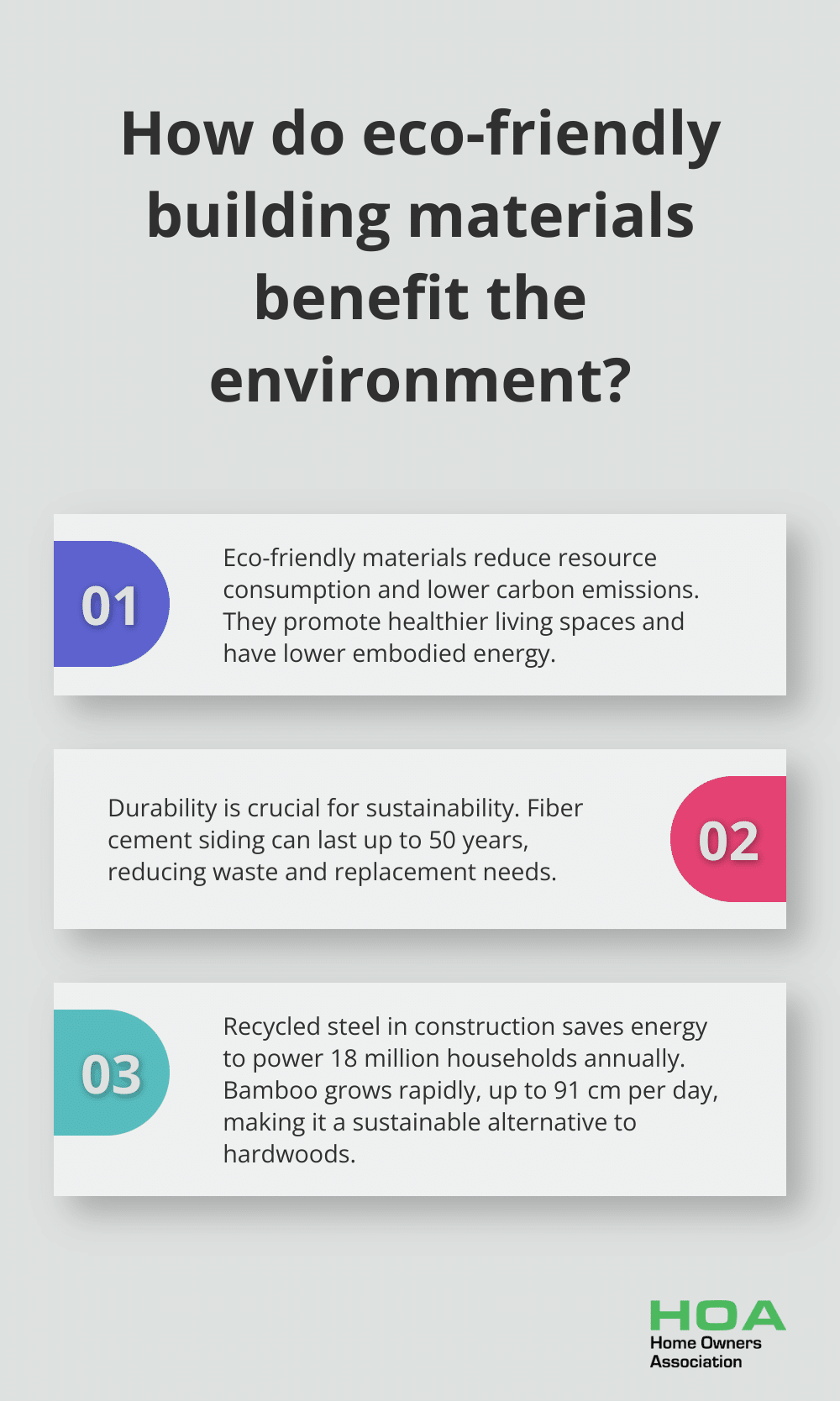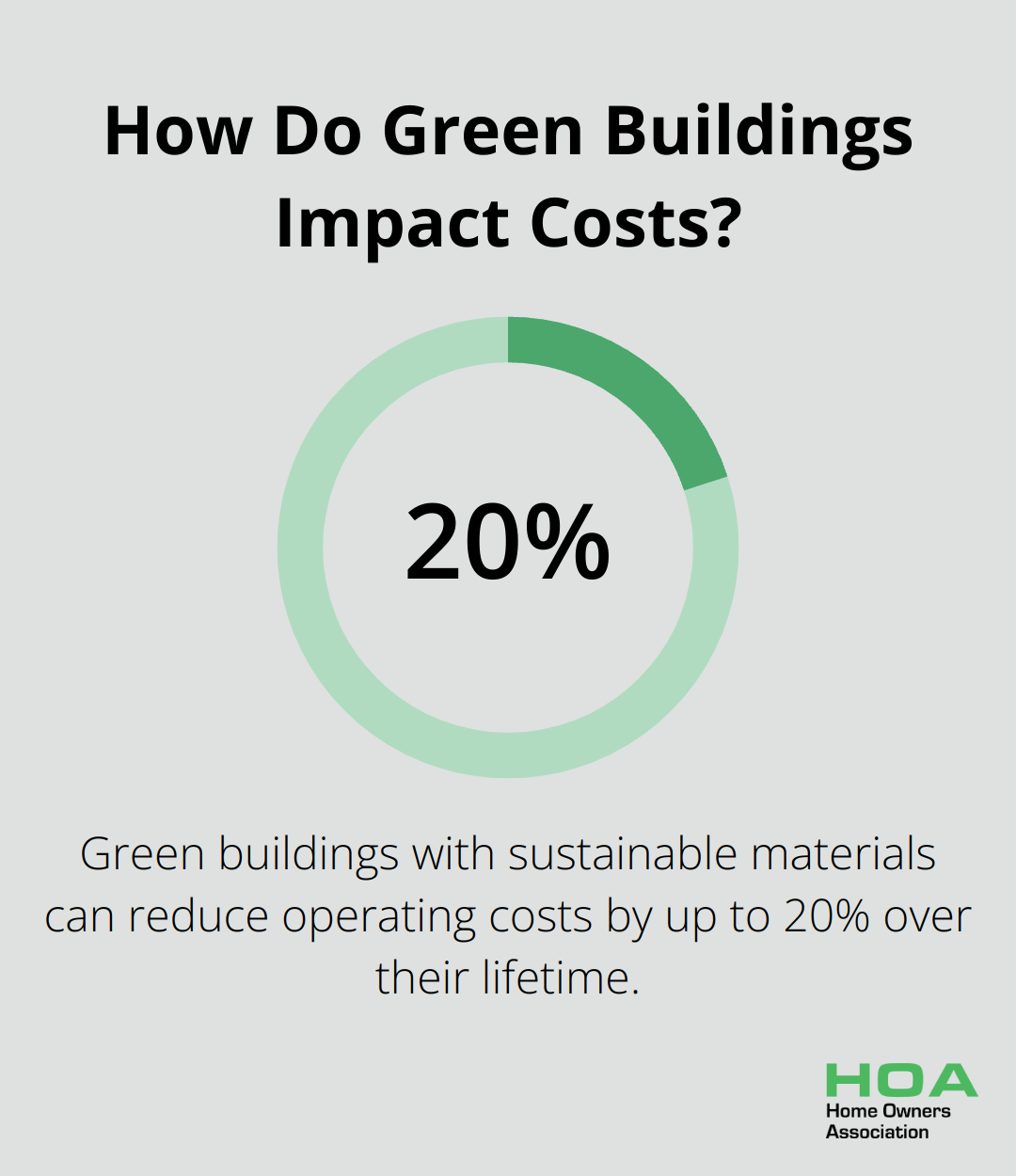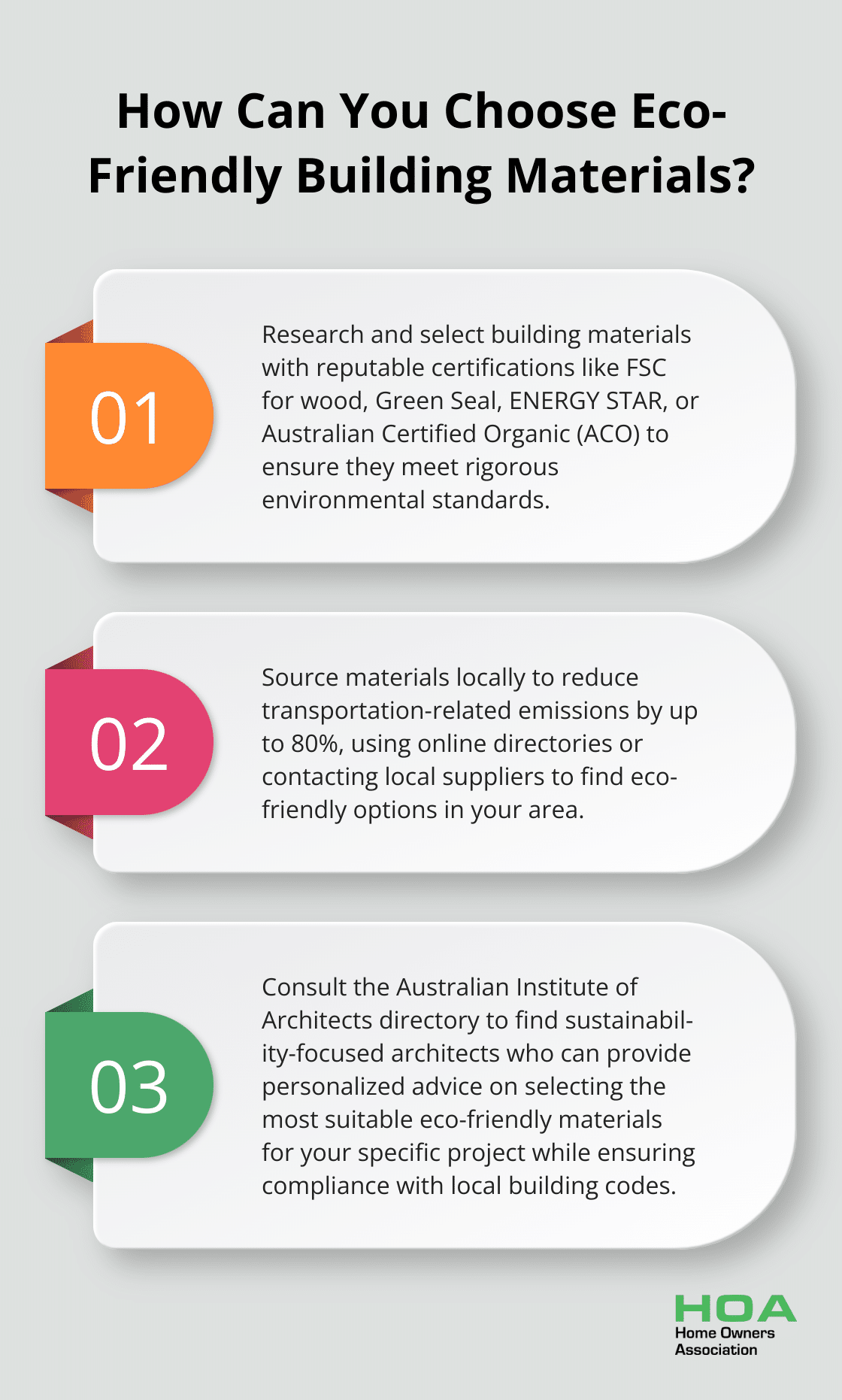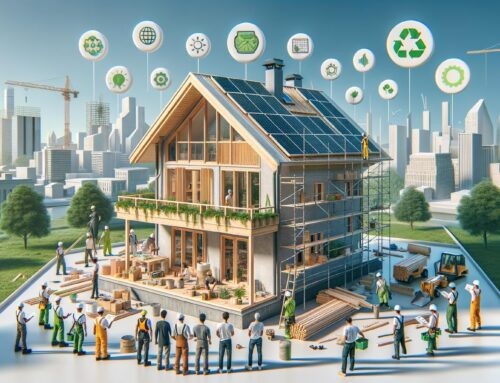
At Home Owners Association, we understand the growing importance of sustainable construction practices. Choosing building materials that are eco-friendly is a critical step in reducing environmental impact and creating healthier living spaces.
This guide will help you navigate the world of sustainable building materials, from understanding their key characteristics to evaluating their environmental impact. We’ll also provide practical tips for selecting the right eco-friendly options for your home projects.
What Are Eco-Friendly Building Materials?
Definition and Key Characteristics
Eco-friendly building materials minimize environmental impact throughout their lifecycle. These products reduce resource consumption, lower carbon emissions, and promote healthier living spaces. The demand for sustainable construction options across Australia continues to grow.

When selecting eco-friendly building materials, consider products with low embodied energy (the total energy required to produce, transport, and install the material). Locally sourced stone, for example, typically has lower embodied energy compared to imported alternatives.
Durability stands out as a key factor. Materials that last longer reduce the need for replacements, ultimately decreasing waste. Fiber cement siding can last up to 50 years, significantly outperforming many traditional options.
Recyclability and recycled content also play important roles. The Steel Recycling Institute reports that using recycled steel in construction saves enough energy to power 18 million households for a year (a substantial impact of choosing materials with high recycled content).
Popular Sustainable Building Options
Bamboo has gained popularity as a sustainable building material due to its rapid growth rate (up to 91 cm per day). Its strength and versatility make it an excellent alternative to traditional hardwoods.
Reclaimed wood offers another eco-friendly option rich in character. Repurposing existing timber reduces the demand for virgin wood and preserves forests. This material is particularly popular for flooring and decorative elements in Australian homes.
For insulation, natural materials like sheep’s wool and cellulose offer high R-values while improving indoor air quality. These options become increasingly available and cost-effective across Australia.
Low-VOC (Volatile Organic Compound) paints and finishes create healthier indoor environments. The ability of organic chemicals to cause health effects varies greatly from those that are highly toxic, to those with no known health effect.
Evaluating Environmental Impact
To truly understand the sustainability of building materials, we must consider their entire lifecycle. This includes extraction of raw materials, manufacturing processes, transportation, installation, use, and eventual disposal or recycling.
Carbon footprint serves as a critical metric in assessing environmental impact. Materials with lower carbon emissions during production and transportation contribute to more sustainable construction practices.
The next step in choosing eco-friendly building materials involves evaluating their environmental impact more thoroughly. Let’s explore how to assess the lifecycle of materials and consider their carbon footprint in greater detail.
How We Measure Environmental Impact
Life Cycle Assessment
Life Cycle Assessment (LCA) calculates the environmental impact of products or services throughout their entire lifecycle. This method examines everything from raw material extraction to manufacturing, transportation, use, and eventual disposal or recycling.

A study by the University of Bath revealed that timber frame construction can reduce carbon emissions by up to 23 tonnes per home compared to steel frames. Trees absorb carbon dioxide during growth, which offsets emissions from production and transport.
Carbon Footprint Considerations
The carbon footprint of building materials plays a key role in their environmental impact. This measure accounts for the total greenhouse gas emissions associated with a product throughout its lifecycle.
Embodied carbon from building activity contributed 10% of national carbon emissions in 2023, with upfront carbon contributing 7%. The selection of low-carbon materials can significantly reduce this impact.
Using recycled steel instead of virgin steel can decrease carbon emissions by up to 95%. Similarly, the choice of locally sourced materials can reduce transportation-related emissions by up to 80%.
Recycled and Recyclable Content
The use of recycled materials in construction reduces waste and conserves energy and resources. The Steel Recycling Institute states that recycling steel saves enough energy annually to power 18 million households for a year.
A material’s potential for future recycling holds equal importance. Aluminum, for example, can undergo recycling indefinitely without losing its properties, making it an excellent choice for sustainable construction.
Expert Advice and Resources
Home Owners Association offers expert advice on selecting materials with high recycled content and strong recyclability potential. This guidance helps ensure that construction projects contribute to a circular economy.
The consideration of these factors – life cycle assessment, carbon footprint, and recycled content – allows homeowners to make informed decisions that minimize the environmental impact of their building projects. The next section will provide practical tips for selecting these eco-friendly materials, helping you navigate the complex world of sustainable construction.
How to Select Eco-Friendly Materials
Understanding Certifications
When you evaluate building materials, look for reputable certifications. The Forest Stewardship Council (FSC) certification ensures wood products come from responsibly managed forests. For other materials, the Green Seal or ENERGY STAR labels indicate products that meet rigorous environmental standards. The Australian Certified Organic (ACO) mark is another trustworthy indicator for natural building materials.
Prioritize Local Sourcing
Choose locally sourced materials to reduce transportation-related emissions. A study by the University of Melbourne found that using local materials can cut carbon emissions by up to 80% compared to imported alternatives. Check with local suppliers or use online directories to find eco-friendly options in your area.
Balance Cost and Sustainability
Some eco-friendly materials may have higher upfront costs, but they often prove more economical in the long run. For instance, metal roofing typically costs more upfront but can last 50+ years, while asphalt shingles are less expensive initially but may need replacement after 20-30 years. Consider the lifecycle costs, including maintenance and potential energy savings, when you compare options.

A report from the Green Building Council of Australia found that green buildings with sustainable materials can reduce operating costs by up to 20% over their lifetime. This translates to significant savings for homeowners who select eco-friendly options.
Seek Expert Advice
Consult with green building professionals to gain valuable insights into the most suitable eco-friendly materials for your specific project. These experts can help you navigate the complexities of sustainable construction and ensure compliance with local building codes.
The Australian Institute of Architects offers a directory of sustainability-focused architects who can guide you through the material selection process. These professionals can provide personalized advice tailored to your project’s needs.
Consider Long-Term Benefits
Think about the long-term benefits of eco-friendly materials when you make your selections. These benefits include improved indoor air quality (due to low-VOC materials), reduced energy costs (from better insulation and energy-efficient windows), and increased property value (as sustainable homes become more desirable in the market).
Final Thoughts
Eco-friendly building materials reduce environmental impact and create healthier living spaces. Factors such as life cycle assessments, carbon footprints, and recycled content help you make informed decisions that benefit your home and the planet. Certifications like FSC, Green Seal, and ENERGY STAR guide you to sustainable options.

Local sourcing supports your community and cuts transportation emissions. Building materials that are eco-friendly often prove more economical long-term due to durability, lower maintenance, and energy savings. These materials also improve indoor air quality, reduce energy consumption, and increase property value.
Home Owners Association encourages sustainable choices in your home projects. Our team provides expert advice on eco-friendly materials for Melbourne homeowners. Your informed decisions about building materials invest in a greener, healthier future for all.





